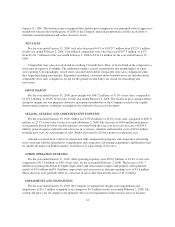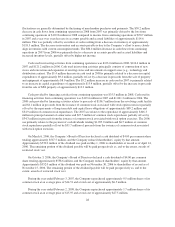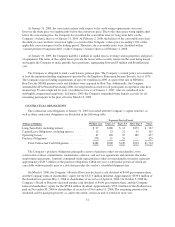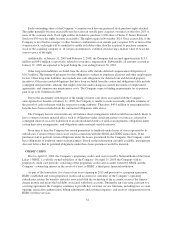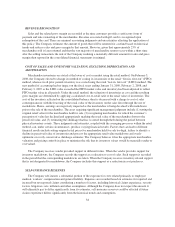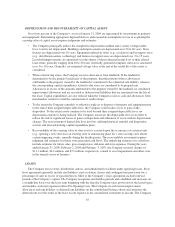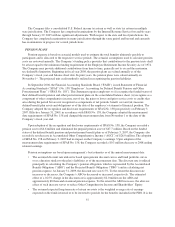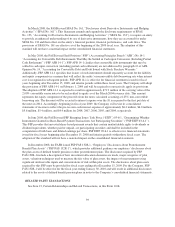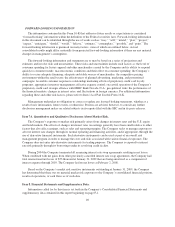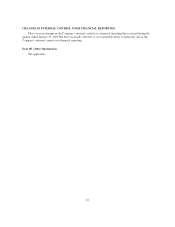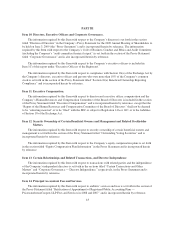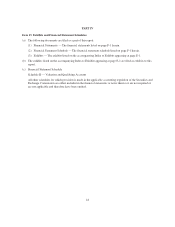Saks Fifth Avenue 2008 Annual Report Download - page 35
Download and view the complete annual report
Please find page 35 of the 2008 Saks Fifth Avenue annual report below. You can navigate through the pages in the report by either clicking on the pages listed below, or by using the keyword search tool below to find specific information within the annual report.REVENUE RECOGNITION
Sales and the related gross margin are recorded at the time customers provide a satisfactory form of
payment and take ownership of the merchandise. Revenue associated with gift cards is recognized upon
redemption of the card. There are minimal accounting judgments and uncertainties affecting the application of
this policy. The Company estimates the amount of goods that will be returned for a refund based on historical
trends and reduces sales and gross margin by that amount. However, given that approximately 25% of
merchandise sold is later returned and that the vast majority of merchandise returns occur within a short time
after the selling transaction, the risk of the Company realizing a materially different amount for sales and gross
margin than reported in the consolidated financial statements is minimal.
COST OF SALES AND INVENTORY VALUATION, EXCLUDING DEPRECIATION AND
AMORTIZATION
Merchandise inventories are stated at the lower of cost or market using the retail method. On February 3,
2008, the Company elected to change its method of costing its inventories to the retail “first-in, first-out” (FIFO)
method, whereas in all prior periods inventory was costed using the retail “last-in, first-out” (LIFO) method. The
new method of accounting had no impact on the fiscal years ending January 31, 2009, February 2, 2008, and
February 3, 2007 as the LIFO value exceeded the FIFO market value and inventory had been adjusted to reflect
FIFO market value in all periods. Under the retail method, the valuation of inventories at cost and the resulting
gross margins are determined by applying a calculated cost-to-retail ratio to the retail value of inventories. The
cost of the inventory reflected on the consolidated balance sheet is decreased with a charge to cost of sales
contemporaneous with the lowering of the retail value of the inventory on the sales floor through the use of
markdowns. Hence, earnings are negatively impacted as the merchandise is being devalued with markdowns
prior to the sale of the merchandise. The areas requiring significant management judgment include (1) setting the
original retail value for the merchandise held for sale, (2) recognizing merchandise for which the customer’s
perception of value has declined and appropriately marking the retail value of the merchandise down to the
perceived value, and (3) estimating the shrinkage that has occurred through theft during the period between
physical inventory counts. These judgments and estimates, coupled with the averaging processes within the retail
method, can, under certain circumstances, produce varying financial results. Factors that can lead to different
financial results include setting original retail prices for merchandise held for sale too high, failure to identify a
decline in perceived value of inventories and process the appropriate retail value markdowns and overly
optimistic or overly conservative shrinkage estimates. The Company believes it has the appropriate merchandise
valuation and pricing controls in place to minimize the risk that its inventory values would be materially under or
overvalued.
The Company receives vendor provided support in different forms. When the vendor provides support for
inventory markdowns, the Company records the support as a reduction to cost of sales. Such support is recorded
in the period that the corresponding markdowns are taken. When the Company receives inventory-related support
that is not designated for markdowns, the Company includes this support as a reduction in cost purchases.
SELF-INSURANCE RESERVES
The Company self-insures a substantial portion of the exposure for costs related primarily to employee
medical, workers’ compensation and general liability. Expenses are recorded based on estimates for reported and
incurred but not reported claims considering a number of factors, including historical claims experience, severity
factors, litigation costs, inflation and other assumptions. Although the Company does not expect the amount it
will ultimately pay to differ significantly from its estimates, self-insurance reserves could be affected if future
claims experience differs significantly from the historical trends and assumptions.
34


